RPG Stats Explained | Attributes, Video Game Stats & Character Points
In role-playing games, RPG stats are the backbone of every character. They define abilities, shape strengths and weaknesses, and influence how a game unfolds. For players, these numbers represent more than values; they bring characters to life.
But what does attributes mean in this context? In video games, attributes are the measurable qualities that determine how a character acts, fights, or interacts with others. From tabletop classics to modern gaming, statistics remain central to progression, strategy, and storytelling.
What Are RPG Stats?
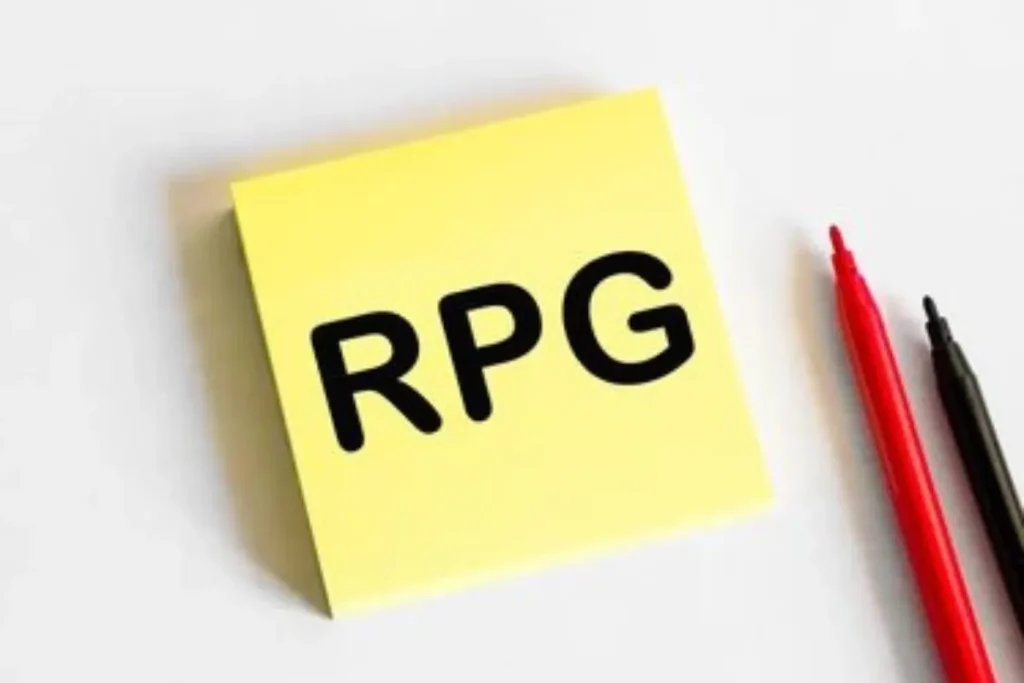
At their core, RPG stats are numerical values that represent character attributes in games. These numbers act as a framework to measure performance, making it possible for rules to guide combat, exploration, or dialogue. In simple terms, when players ask what stats are in games, they are referring to the numbers that drive the outcomes of actions.
In a video game or tabletop setting, statistics create fairness and balance. Every swing of a sword, roll of dice, or spell cast connects back to a stat. This link between characters and outcomes is what turns imagination into structured play.
From a design perspective, game statistics help developers build consistent systems. Just as mathematics supports real-world analysis, attributes in statistics support predictable results in gaming. This is why some players call RPGs a kind of statistics game or video game simulation, where numbers drive both challenges and victories.
Just like professionals earn CPE credits to maintain balance in their careers, games use stats to maintain balance in character progression.
Core RPG Attributes and Their Role
The foundation of most role-playing games lies in six classic RPG stats: Strength, Dexterity, Constitution, Intelligence, Wisdom, and Charisma. Often called D&D attributes, these values have influenced both tabletop and video game design for decades.
They act as important attributes that define every hero’s abilities. Each attribute reflects a different aspect of a character’s potential, shaping playstyle, story, and outcomes.
Strength (STR)
Strength represents raw physical power. It affects melee damage, carrying capacity, and heavy tasks. In many games, hero attributes begin with STR, since it measures a fighter’s ability to overpower foes and survive combat.
Dexterity (DEX)
Dexterity covers agility, reflexes, and accuracy. It is the skills stat that defines speed, balance, and precision. Many character stat names link DEX with dodging attacks or hitting targets more reliably.
Constitution (CON)
The constitution states measures of endurance and resilience. It influences hit points (HP) and resistance to exhaustion. In DND attributes and similar systems, it is the difference between survival and defeat.
Intelligence (INT)
INT reflects knowledge and reasoning. It is tied to spell statistics and magical ability, but also problem-solving and planning. As an attribute of a character, it helps define wizards, scholars, and strategists.
Wisdom (WIS)
Wisdom represents intuition, awareness, and judgment. It strengthens perception and willpower. Considered one of the mental attributes, WIS shapes how a character understands the world and reacts to danger.
Charisma (CHA)
Charisma relates to personality, influence, and persuasion. It drives leadership, negotiations, and relationships. In D&D, it even affects magic for certain classes. Many d and d personality traits and characteristics of characters rely on CHA.
Similar to how learners earn CPE credits step by step, players earn points to allocate to attributes.
Other Common RPG Stats
Beyond the six core attributes, most games add secondary RPG stats to expand depth and variety. These values refine how a character behaves in battle or story events.
A complete stat list often includes health, magic, defense, and luck. Each game may adjust these numbers, but their stat use remains similar across genres.
Hit Points (HP)
HP is the most common stat in any RPG. It measures how much damage a character can take before being defeated. In short, HP video game meaning equals survival, as losing HP usually means losing the fight.
Magic Points (MP / SP)
MP or SP represents magical energy or skill power. This stat governs how often a character can cast spells or use abilities. Without MP, even the strongest mage becomes powerless.
Speed and Agility
Speed defines turn order in battles, while agility controls dodging or landing hits. Many stat categories in tactical RPGs rely on speed to balance quick but fragile characters against slow but powerful ones.
Luck and Critical Chance
Luck affects rare drops, critical hits, and unexpected outcomes. Some stat names also connect luck to gambling mechanics or probability. It plays a small role in story-driven games but is central in many stat games.
Defense and Magic Defense
Armor and resistance values reduce incoming damage. Character status screens often separate physical and magical defense into two stat categories for clarity.
Willpower (WIL)
Willpower measures mental strength and resistance to mind-control or fear. It is a common addition in RPGs with heavy narrative or horror elements.
This mirrors how users debate Goodnotes vs Notability for note-taking preferences, where each option has strengths depending on playstyle.
RPG Stat Systems Across Games
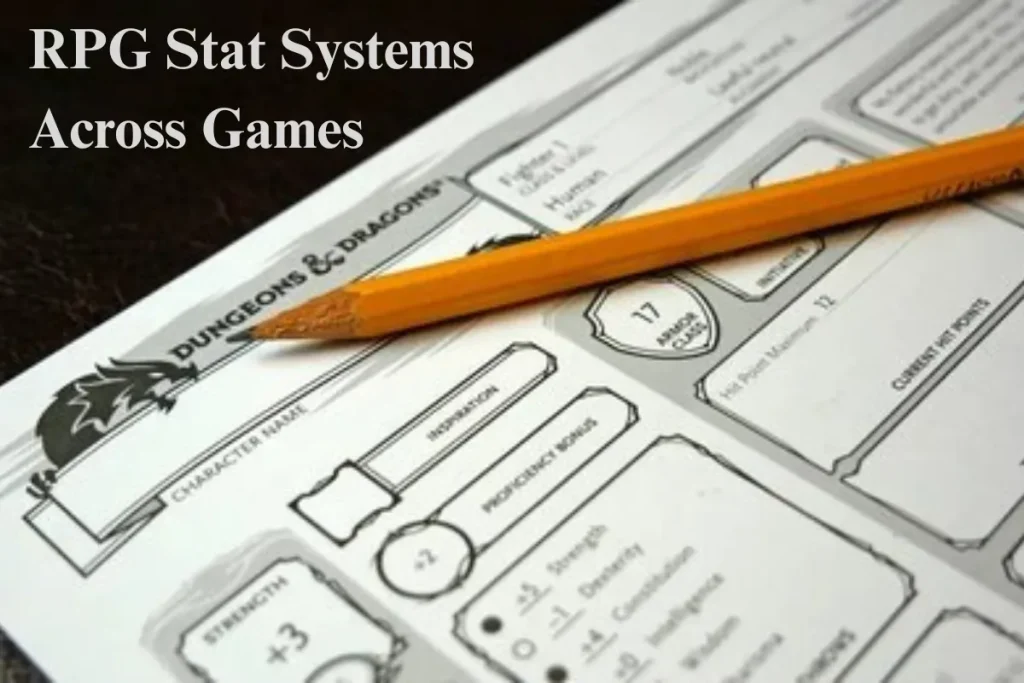
Different games approach RPG stats in unique ways, yet most systems share a common goal: to create balance and variety. The best-known example is Dungeons and Dragons attributes, which shaped the role-playing genre.
In 5e attributes, players assign numbers to Strength, Dexterity, Constitution, Intelligence, Wisdom, and Charisma, forming the foundation of their characters. These dnd attributes explained how different heroes excel in combat, exploration, or social encounters.
In MMORPGs, designers expand stats into dozens of categories. Alongside the core six, players may manage vitality, agility, endurance, or magical power. This reflects how different attributes are used to provide specialization in online games, where every game character must stand out in a large community.
Tabletop role-playing also allows for flexibility. Some systems reduce stats to just 3 attributes, while others list all in dnd alongside custom traits. Forums discussing popular tabletop games often debate whether fewer or more numbers create a better experience.
Video games mirror these systems but automate the math. A statistical character model ensures fairness, while still giving depth. Whether in a fantasy RPG or a sci-fi setting, stats remain the invisible rules that keep adventures engaging and fair.
How Many Stats Should an RPG Use?
One of the biggest design choices in RPGs is deciding how many stats to include. Some systems keep it minimalist with just a few core attributes, making it easier for new players to learn and reducing complexity in gameplay.
Others go for complex stat sets, introducing multiple categories and substats that allow for deeper character customisation and strategy. The right balance often depends on the game’s audience, theme, and user experience (UX) goals.
For example, a story-focused RPG may benefit from fewer stats, while a tactical RPG thrives on detailed stat systems. Ultimately, player preference matters—some enjoy simplicity, while others love micromanaging detailed numbers. A well-designed system ensures stats feel meaningful without overwhelming the player.
Stats and Character Progression
Progression is the heart of role-playing games, and RPG stats are central to that journey. As players level up, they gain opportunities to increase character statistics, unlocking new skills and abilities. This growth transforms early adventurers into powerful heroes.
Most systems use character status screens to track progression. Here, players see current values for health, magic, defense, and other traits. A video game character template often highlights these values, making it easy to compare and plan upgrades.
Designers sometimes use point-buy methods, where assigning numbers to stats for characters creates customization. This reflects one of the characteristics of games—allowing choice and control over development. Some RPGs also use automated systems, where a stat maker tool calculates growth according to class or role.
From tabletop dice rolls to video game character traits in digital adventures, progression makes numbers feel meaningful. Even in simplified game statistics systems, players value the sense of improvement. Growth through stats ensures every quest feels rewarding and every challenge achievable.
Attributes vs Characteristics in Games
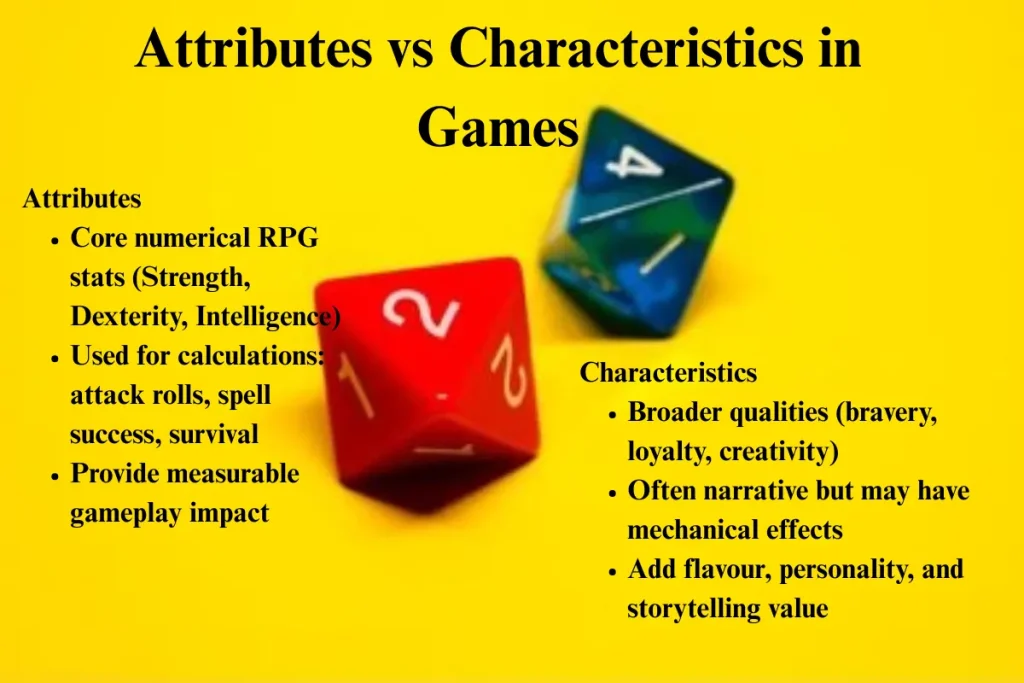
In RPG design, attributes and characteristics are often used interchangeably, but they play slightly different roles in defining characters. Attributes usually refer to the core numerical role-playing game stats—such as Strength, Dexterity, and Intelligence—that act as the foundation of gameplay. These stats provide measurable numbers for calculations, influencing attack rolls, spell success, or survival chances.
Characteristics, on the other hand, often describe broader qualities that add depth to a character. For example, bravery, loyalty, or creativity may not always appear on the game statistics sheet, but still shape how a player approaches challenges. Some systems formalise these into mechanical effects, while others keep them narrative.
Ultimately, both attributes and characteristics contribute to identity. Attributes bring precision and numbers into statistics in games, while characteristics provide flavour, personality, and storytelling value. Together, they balance structure with creativity, ensuring every hero feels unique in both gameplay and narrative.
The Nature of RPG Attributes
Attributes are numeric proxies for what a character can do, linking identity to action resolution. They turn intent into outcomes by feeding rules for attacks, saves, skill checks, and social moves. In practice, character attributes define limits, enable specialisation, and pace growth.
Attributes also standardise game statistics so results feel fair and repeatable. Designers use them to translate fiction into mechanics, keeping the world consistent in games where chance and choice intersect. This is why players ask what attributes mean: they are the measurable levers that drive success or failure.
Clear models separate attributes from characteristics without confusion. Attributes are the numbers used by the engine; characteristics are the descriptive traits that colour personality and style. Good systems keep both visible for characters and keep names readable for games, so players understand cause and effect at a glance.
This is similar to AI art styles, where consistent themes keep the design immersive and believable.
Common Attribute Systems and Set Attribute Systems
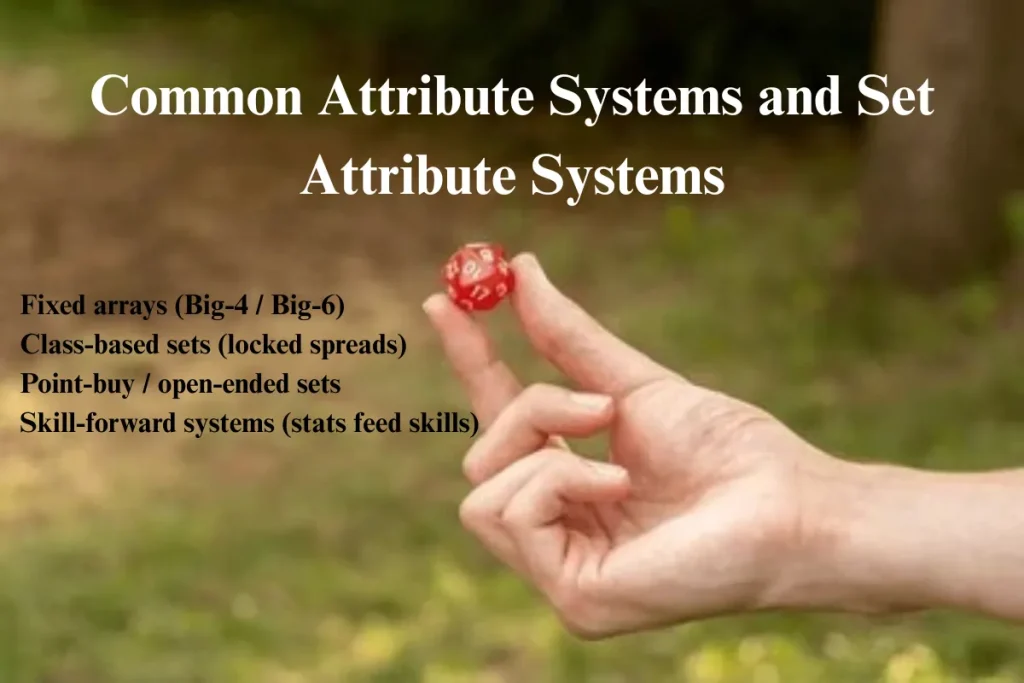
Different attribute systems shape how players build and read characters. A set attribute system establishes shared expectations, while flexible models trade standardisation for custom flavour. Choosing the right approach affects balance, learning curve, and long-term variety.
Fixed arrays (Big-4 / Big-6)
Fixed arrays present a small, universal spread. Big-4 favours clarity (often STR, AGI/DEX, INT, CHA). Big-6 adds CON and WIS for coverage of resilience and perception. These stat categories are easy to teach and compare.
Class-based sets (locked spreads)
Class frameworks predefine spreads per role. A defender starts high in CON/STR; a caster leads with INT/WIS. This speeds onboarding and preserves identity while limiting edge-case min-maxing.
Point-buy / open-ended sets
Point-buy grants pools to allocate across attributes. Caps, floors, and costs prevent abuse while supporting assigning points and personal builds. Open-ended variants allow rare, thematic extremes.
Skill-forward systems (stats feed skills)
Skills do the heavy lifting, while attributes provide modifiers. This keeps the skills stat readable and lets the game spotlight activities like stealth, crafting, or persuasion without bloating base attributes.
Fitting the Setting and Common Attribute Names
Attributes work best when they match the world’s tone and threats. Genre alignment ensures numbers support story stakes and the kinds of challenges players face.
Genre alignment (fantasy, sci-fi, horror)
Fantasy favours Strength, Dexterity, Constitution, Intelligence, Wisdom, and Charisma for martial, mystical, and social play. Sci-fi often swaps in Tech, Logic, or Psi to reflect devices and mental prowess. Horror leans on Sanity, Resolve, and Fear to model stress and survival under pressure.
Naming conventions (STR, AGI/DEX, VIT/CON, INT, WIS, CHA)
Common abbreviations keep sheets compact and universal. STR, AGI/DEX, VIT/CON, INT, WIS, and CHA are familiar stat names across tabletop and digital games. Synonyms signal flavour without changing function: AGI vs DEX, VIT vs CON, or LUK for fortune. Use a concise list and a clean chart so the table, UI, and tooltips stay readable while the rules remain precise.
Classifications: Physical, Mental, Social, Resource
Attributes often fall into four broad classifications that balance character performance across different dimensions. These categories help players and designers maintain clarity while ensuring diverse playstyles remain viable.
Physical stats
Physical attributes such as Strength, Dexterity, and Constitution govern raw power, agility, and resilience. They shape melee damage, carrying limits, and the ability to withstand injuries or exhaustion.
Mental stats
Mental stats include Intelligence, Wisdom, and Perception. They cover problem-solving, memory, intuition, and awareness. These attributes influence skill checks, magic systems, and puzzle-solving mechanics.
Social stats
Charisma, Leadership, and Influence drive dialogue, negotiation, and persuasion mechanics. Social attributes define how a video game character interacts with NPCs and factions.
Resource stats (HP/MP/SP, stamina, focus)
Resource attributes underpin survival. HP measures vitality, MP or mana fuels abilities, and SP often represents stamina or special focus. These stats interact with attribute statistics to control pacing, endurance, and resource management in combat and exploration.
Core vs Derived: Stats and Substats
Stat systems often distinguish between core attributes and derived substats, where base numbers feed formulas that generate secondary performance metrics. This relationship maintains both simplicity and depth.
From base to derived (e.g., CON → HP)
Core stats like Constitution or Vitality translate into derived values such as HP. Strength may determine carrying capacity, while Dexterity affects accuracy. This conversion anchors realism in game design.
Scaling, soft caps, and diminishing returns
Derived stats scale from core values, but designers often introduce soft caps to curb exponential growth. For example, doubling Dexterity won’t endlessly raise evasion; diminishing returns ensure balance and prevent runaway characters.
Cross-stat formulas (interdependencies)
Many systems link attributes together. For instance, Attack Power may depend on both Strength and Dexterity, while Mana Regeneration might factor in Intelligence and Wisdom. These cross-stat formulas enrich character building, rewarding synergy while forcing trade-offs. Properly tuned, derived stats encourage experimentation and maintain fairness across both minimalist and complex stat games.
Similar to how a GPU test benchmarks performance step by step, derived stats calculate accuracy, damage, and other outcomes in sequence.
Combat Stat Suite (Attack to Luck)
Combat attributes are often the most visible numbers on a character sheet. They define performance in battle, blending strategy with probability to create tense and rewarding encounters.
Attack & Magic Attack
Attack reflects physical offense, influenced by Strength or weapon stats. Magic Attack governs spell potency, usually tied to Intelligence or Wisdom. Together, they measure raw output across melee and magical systems.
Defense & Magic Defense
Defense absorbs physical damage, while Magic Defense reduces magical or elemental effects. These stats often scale with Constitution or specific resistances, forming the backbone of survivability.
Speed (turn order)
Speed determines initiative, turn frequency, and sometimes movement range. Faster characters act more often, shaping tactics and resource flow.
Evasion & Accuracy
Accuracy ensures attacks land, scaling with Dexterity or focus-based substats. Evasion gives opponents a chance to avoid hits, often with diminishing returns at higher levels. This balance prevents extremes of guaranteed hits or endless misses.
Critical & Luck
Critical Chance introduces burst damage potential, while Luck modifies crits, drops, and hidden rolls. Together, they bring unpredictability and excitement to combat. Well-tuned luck-based attributes reward risk-taking without breaking balance, making every strike meaningful.
Statistics in Video Games and Real Life
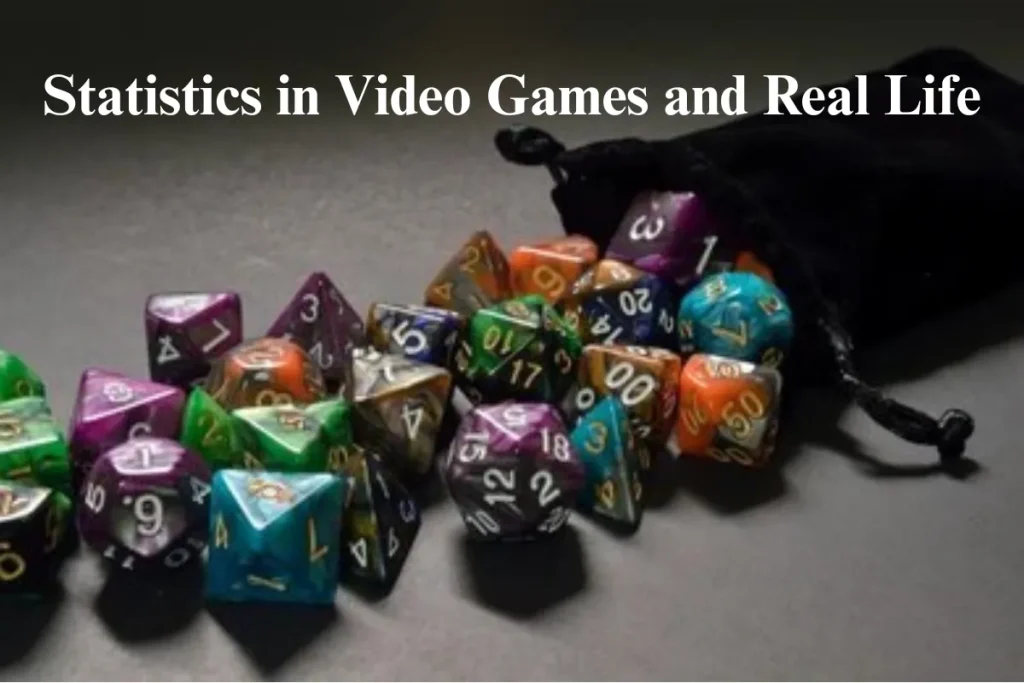
The use of statistics on video games goes beyond entertainment—it reflects how numbers and systems shape both virtual and real experiences. In RPGs, attribute statistics like Strength, Dexterity, and Intelligence determine combat outcomes, exploration success, and story progression. These attributes in statistics form the backbone of character creation, ensuring each hero feels unique.
Interestingly, video gaming statistics also reveal insights about player behaviour and preferences in real life. For example, a statistic about video games might show how many hours the average video game player spends weekly or how certain genres attract different age groups. Just like RPG attributes, these numbers provide a measurable way to understand trends and performance.
Beyond gaming, statistics serve as decision-making tools in education, sports, and business. Just as RPGs use numbers to define capabilities, real life relies on data to track growth, evaluate risks, and guide strategies. This connection highlights how statistics in games mirror real-world applications of numbers in shaping outcomes.
RPG Stat Lists and Generators
Every role-playing game uses a stat list to define characters, usually grouped into stat categories such as physical, mental, and magical. These categories are often presented in a chart for easy reference.
For players designing an RP character, tools like a generator or a template make the process quicker and more balanced. A video game template or video game character sheet provides a ready-made structure where attributes like Strength, Dexterity, and Luck can be adjusted.
Modern stat games and statistic games even include automated systems that randomly assign or optimise stats, making character creation more exciting. These lists and generators ensure consistency while giving players creative freedom to build unique characters.
Much like how saved files on iPhone follow a clear storage hierarchy, stats in games rely on layered data models.
Why Have Stats? Design Purposes
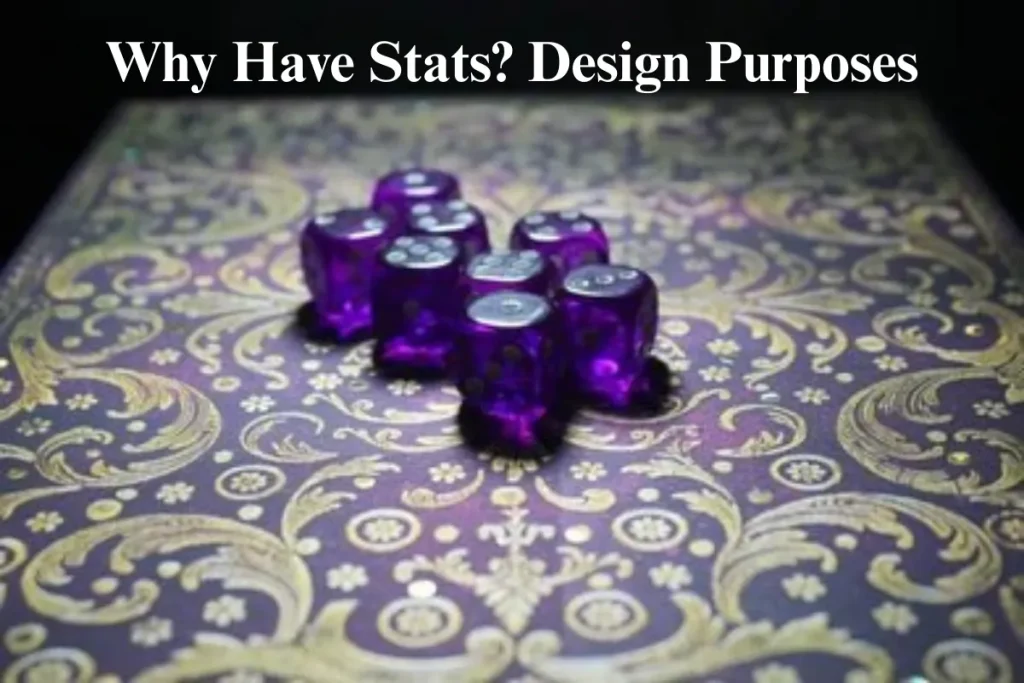
Game designers include statistics not just for numbers, but to shape the entire play experience. Stats give structure, balance, and identity to both characters and worlds.
1) The simulation requires it
At the most basic level, stats allow systems to function. Without measurable attributes like Strength or Speed, combat, skill checks, and progression would lack consistency. A good attribute system turns abstract concepts into playable mechanics.
2) Thematic coherence
Stats also tie into a game’s setting. A cyberpunk RPG might use Hacking or Tech Aptitude, while a survival game tracks Stamina and Hunger. Aligning mechanics with theme creates immersion, making the numbers feel natural rather than arbitrary.
3) Define by difference (party roles)
Finally, stats enable variety by separating roles. A tank relies on Constitution and Defense, a mage invests in Intelligence and Mana, while a rogue leans on Dexterity and Evasion. This differentiation encourages teamwork, builds diversity, and replayability—core reasons stats remain central to RPG design.
Compared to choosing an ISO keyboard layout versus alternatives, party roles are defined by subtle but important differences.
Implementing Stats (General Stat Class & Modifiers)
Behind the scenes, stats often follow a structured data model. This ensures clarity for both designers and players while allowing flexible expansion.
Data model (base, temp, bonus, total)
A common system splits stats into four layers: base values (the permanent core), temporary modifiers (from spells or conditions), bonus values (from gear or passive perks), and the final total used in calculations. This layered approach prevents conflicts and allows clear stacking rules.
class Stat:
def __init__(self, base=0):
self.base = base # permanent value
self.temp = 0 # temporary effects (buffs/debuffs)
self.bonus = 0 # items, passives
self.total = base # final calculated stat
def update(self):
self.total = self.base + self.temp + self.bonusBuffs/debuffs, auras, item bonuses
Dynamic modifiers like buffs, debuffs, and environmental auras feed into the stat pipeline. Equipment bonuses often apply as separate layers, ensuring they interact predictably with temporary effects. Proper stacking rules prevent unintended exploits such as infinite damage loops.
strength = Stat(10)
# Buff from a spell
strength.temp += 5
# Item bonus from sword
strength.bonus += 3
strength.update()
print("Final Strength:", strength.total)
# Output → Final Strength: 18Derived calculations & update order
Many stats feed into others—Dexterity may recalculate Accuracy, which updates Hit Chance, which then informs Combat Resolution. For fairness, games use a strict update order: apply base → add bonuses → check temporary effects → calculate derived. This order ensures transparency, reduces bugs, and keeps the math intuitive for players who want to optimise builds.
class Character:
def __init__(self, strength, dexterity):
self.strength = Stat(strength)
self.dexterity = Stat(dexterity)
# derived stats
self.attack = 0
self.accuracy = 0
def update_stats(self):
# update base layers first
self.strength.update()
self.dexterity.update()
# derived from core stats
self.attack = self.strength.total * 2
self.accuracy = self.dexterity.total * 1.5Secret and Hidden Stats
Not all statistics are visible to players. Many RPGs include hidden attributes that quietly shape gameplay without cluttering the UI.
Examples include morale, which affects enemy retreat chances, affinity, which influences NPC relationships, and aggro weight, which determines how AI targets characters in battle. Some titles even track hidden encounter luck, controlling rare spawns or critical events.
Designers hide these stats to maintain immersion, mystery, and unpredictability. Revealing every calculation risks reducing decisions to spreadsheets. Instead, hidden attributes encourage players to experiment, share discoveries, and experience surprise—key elements of engaging game design.
Comparable to creating strong password ideas where some elements remain hidden, designers often conceal stats like morale or encounter luck.
The BIG 4 Attribute Model
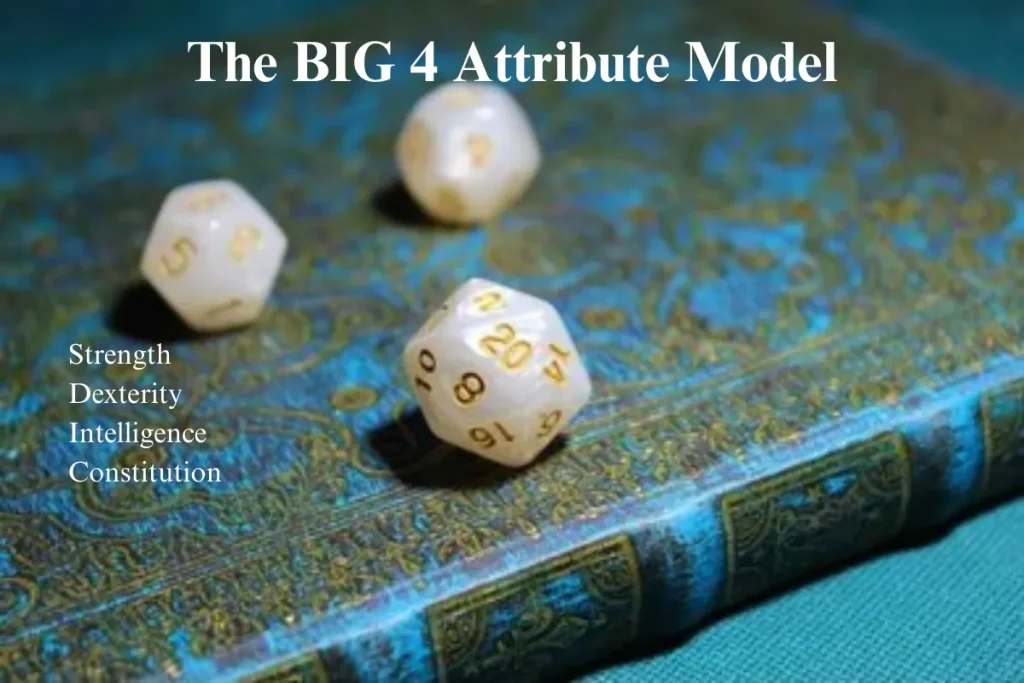
Many RPGs simplify their design by using the Big 4 attributes: Strength, Dexterity, Intelligence, and Constitution. These four cover the most essential pillars—physical power, agility, mental ability, and resilience.
Compared to the more detailed Big 6 model (like Dungeons & Dragons’ Strength, Dexterity, Constitution, Intelligence, Wisdom, Charisma), the Big 4 trades granularity for speed. It keeps character sheets clean, reduces bookkeeping, and lowers entry barriers for new players.
This model works well in video games, where streamlined design avoids overwhelming the player. However, it sacrifices social and thematic nuance. Choosing between the Big 4 and larger sets depends on whether a game prioritises simplicity or depth.
Just like a Goodnotes review might weigh simplicity vs complexity, RPGs sometimes reduce six attributes into a streamlined big-4 model.
Popular Tabletop Attribute Examples
Tabletop RPGs have historically defined how attributes shape characters, with several systems leaving lasting legacies.
Dungeons & Dragons (D&D) popularised the Big 6: Strength, Dexterity, Constitution, Intelligence, Wisdom, and Charisma. Each covers a distinct role, blending combat utility with social and mental checks. This model has become the industry standard, influencing countless RPGs.
Other systems take different approaches. Call of Cthulhu focuses on investigative attributes such as Sanity and Education, reflecting its horror and mystery tone.
GURPS uses a four-attribute model (Strength, Dexterity, Intelligence, Health), emphasising flexibility and universal application. Shadowrun mixes physical, mental, and technological stats, introducing Matrix attributes to match its cyberpunk setting.
These examples show how different games emphasise attributes to match the theme. Whether horror, fantasy, or sci-fi, the choice of stats defines both mechanics and the player’s experience of the world.
Types of RPG Statistics: Powers, Skills, Traits
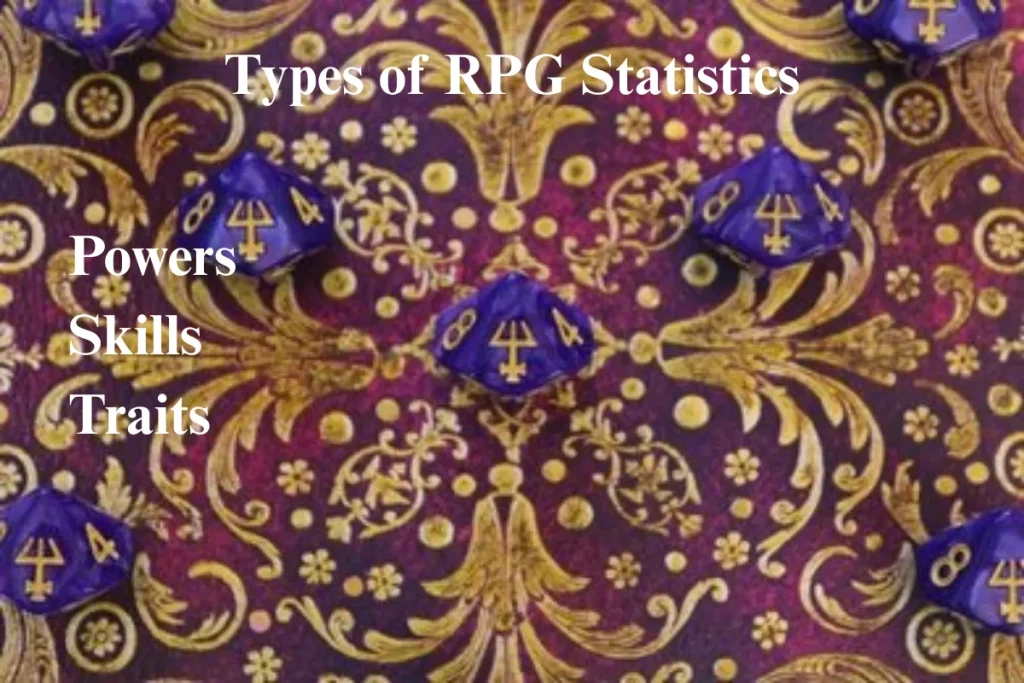
Beyond base attributes, RPGs often layer in powers, skills, and traits to expand character identity.
Powers are abilities unlocked through attributes or progression, such as spellcasting linked to Intelligence or combat techniques tied to Strength. These serve as direct expressions of a character’s build.
Skills represent learned proficiencies, ranging from lockpicking and stealth to alchemy and persuasion. They typically scale with both practice and related stats—Dexterity boosting stealth, or Charisma supporting persuasion.
Traits add flavour by granting passive effects or personality-driven modifiers. A “Brave” trait might reduce fear penalties, while “Greedy” increases loot acquisition at social cost.
Together, these categories create synergy: attributes set the foundation, skills refine expertise, and traits provide a unique flavour. The layering of stats ensures every character feels distinct while rewarding diverse playstyles, whether in tabletop campaigns or RPG video games.
Skills and traits can also shape interaction, much like how a chat bubble system influences user communication in apps.
Character Points, Leveling Up, Assigning Points
One of the most engaging aspects of RPGs is the progression of characters through leveling up and assigning points. Different systems handle this in unique ways. Some use point-buy mechanics, where players receive a pool of points at creation or level-up to allocate across stats, offering flexibility but demanding careful balancing.
Others use milestone progression, where stats increase automatically at set levels or events, ensuring consistency but reducing player control. Many games blend both, letting players fine-tune growth within structured milestones.
An important consideration is respec options—the ability to reassign points later. This prevents “dead builds” and supports experimentation, though unlimited respecs can undermine meaningful choices.
Caps and pacing also shape the experience: low caps make decisions impactful, while higher caps allow gradual, long-term customization. Ultimately, the balance between freedom and structure defines how rewarding stat progression feels, influencing both player satisfaction and replay value.
Interdependencies Between Statistics
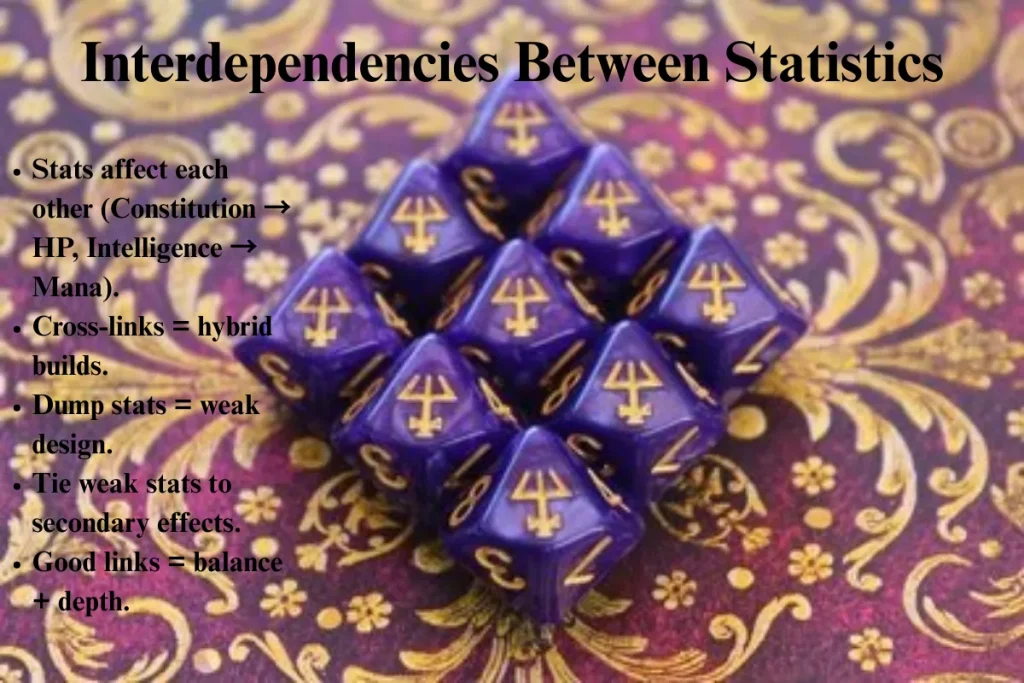
RPG stats rarely exist in isolation; they often feature interdependencies that shape builds and strategy. For example, Constitution might influence both HP and stamina, while Intelligence could scale mana pools and magic damage. These cross-stat formulas encourage hybrid builds where strengths overlap, rewarding players for experimenting with non-obvious combinations.
However, poor design can create dump stats—attributes with little value compared to others. When a stat doesn’t contribute meaningfully to gameplay, players will neglect it, harming balance. To avoid this, designers often tie weaker stats into secondary mechanics (e.g., Charisma affecting shop prices or dialogue outcomes).
Well-designed interdependencies ensure every attribute has a purpose, while still preserving the tradeoffs that make builds distinct. This balance maintains both strategic depth and fairness in progression.
Advantages and Disadvantages of Stat Systems
Stat systems are the backbone of RPG design, but they bring both strengths and challenges. On the advantage side, stats provide clarity and structure, giving players a measurable sense of progression.
They encourage strategic decision-making, create varied builds, and increase replayability by supporting multiple playstyles. Stats also serve as a bridge between narrative and mechanics, reflecting a character’s story arc in numbers.
On the downside, overly complex systems can overwhelm players with analysis paralysis, slowing down gameplay. Poorly balanced stats can lead to dominant strategies, reducing variety, while underused stats become irrelevant “traps.”
Another drawback is that number-heavy systems may pull focus from immersion if players fixate on min-maxing instead of role-playing. Designers must weigh these tradeoffs carefully—finding a sweet spot between depth and accessibility. A well-designed stat system enhances gameplay; a poorly balanced one risks frustrating or alienating players.
Conclusion
Statistics are the foundation of RPG design, shaping how characters grow, interact, and overcome challenges. From core attributes to hidden mechanics, they provide structure and meaning to progression. A well-balanced stat system not only drives combat outcomes but also reinforces narrative themes, ensuring that every choice feels impactful and rewarding.
At the same time, stats must strike a balance between clarity and complexity. Too few, and the system risks feeling shallow; too many, and players may become overwhelmed. The most successful RPGs use stats to encourage experimentation, role differentiation, and long-term engagement—making them more than just numbers, but the soul of character identity and gameplay depth.
FAQs
What are the RPG stats?
RPG stats are numerical values that define a character’s abilities, such as physical power, speed, magic, defence, or social influence. They determine success in actions and progression.
What does RPG stand for?
RPG stands for Role-Playing Game, a genre where players create characters, make choices, and progress through stories or systems based on stats and rules.
What is RPG in NBA stats?
In NBA statistics, RPG means Rebounds Per Game, showing the average number of rebounds a player secures each game.






